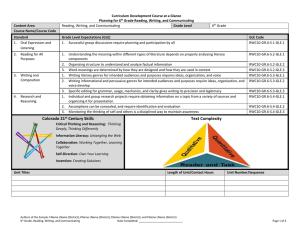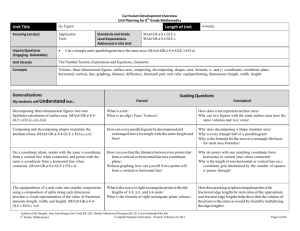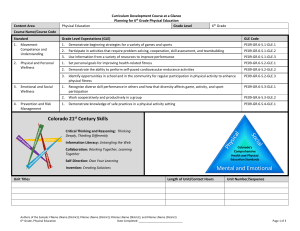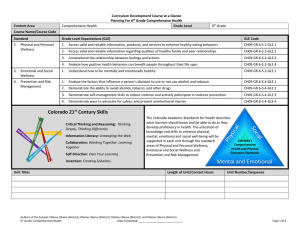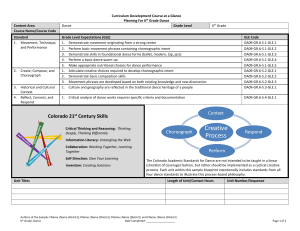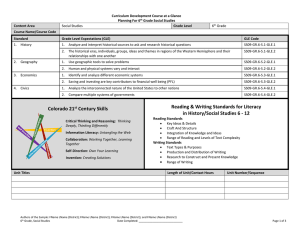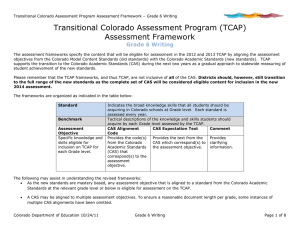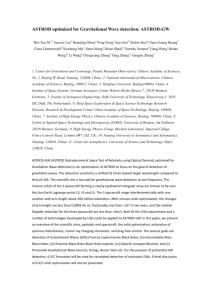Document 15590659
advertisement
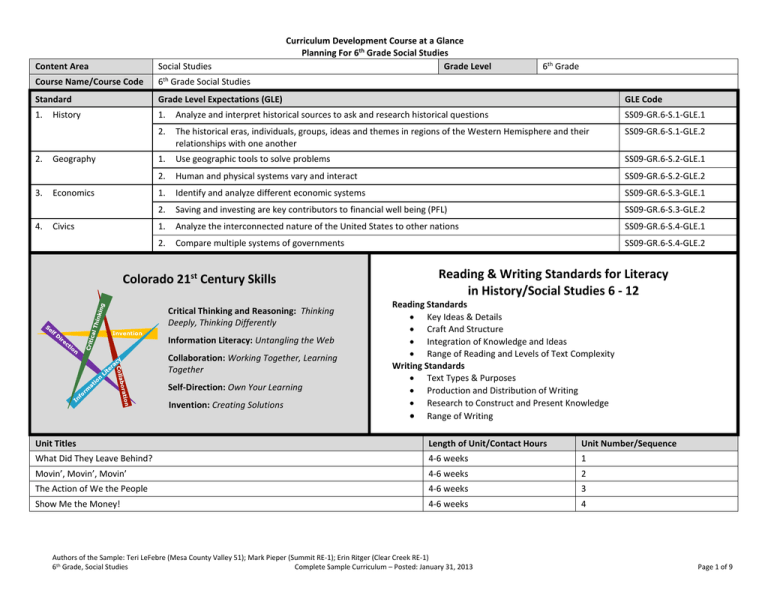
Curriculum Development Course at a Glance Planning For 6th Grade Social Studies Grade Level 6th Grade Content Area Social Studies Course Name/Course Code 6th Grade Social Studies Standard Grade Level Expectations (GLE) GLE Code 1. 1. Analyze and interpret historical sources to ask and research historical questions SS09-GR.6-S.1-GLE.1 2. The historical eras, individuals, groups, ideas and themes in regions of the Western Hemisphere and their relationships with one another SS09-GR.6-S.1-GLE.2 1. Use geographic tools to solve problems SS09-GR.6-S.2-GLE.1 2. Human and physical systems vary and interact SS09-GR.6-S.2-GLE.2 1. Identify and analyze different economic systems SS09-GR.6-S.3-GLE.1 2. Saving and investing are key contributors to financial well being (PFL) SS09-GR.6-S.3-GLE.2 1. Analyze the interconnected nature of the United States to other nations SS09-GR.6-S.4-GLE.1 2. Compare multiple systems of governments SS09-GR.6-S.4-GLE.2 2. 3. 4. History Geography Economics Civics Colorado 21st Century Skills Critical Thinking and Reasoning: Thinking Deeply, Thinking Differently Invention Information Literacy: Untangling the Web Collaboration: Working Together, Learning Together Self-Direction: Own Your Learning Invention: Creating Solutions Reading & Writing Standards for Literacy in History/Social Studies 6 - 12 Reading Standards Key Ideas & Details Craft And Structure Integration of Knowledge and Ideas Range of Reading and Levels of Text Complexity Writing Standards Text Types & Purposes Production and Distribution of Writing Research to Construct and Present Knowledge Range of Writing Unit Titles Length of Unit/Contact Hours Unit Number/Sequence What Did They Leave Behind? 4-6 weeks 1 Movin’, Movin’, Movin’ 4-6 weeks 2 The Action of We the People 4-6 weeks 3 Show Me the Money! 4-6 weeks 4 Authors of the Sample: Teri LeFebre (Mesa County Valley 51); Mark Pieper (Summit RE-1); Erin Ritger (Clear Creek RE-1) 6th Grade, Social Studies Complete Sample Curriculum – Posted: January 31, 2013 Page 1 of 9 Curriculum Development Overview Unit Planning for 6th Grade Social Studies Unit Title What Did They Leave Behind? Focusing Lens(es) Beliefs and Ideals CCSS Reading Standards for Literacy in History/Social Studies 6-8 Length of Unit Standards and Grade Level Expectations Addressed in this Unit CCSS.RH.6-8.2, CCSS.RH.6-8.4, CCSS.RH.68.5, CCSS.RH.6-8.7, CCSS.RH.6-8.9 4-6 weeks SS09-GR.6-S.1-GLE.1 SS09-GR.6-S.1-GLE.2 SS09-GR.6-S.2-GLE.2 CCSS Writing Standards for Literacy in History/Social Studies 6-8 CCSS.WHST.6-8.1, CCSS.WHST.6-8.4, CCSS.WHST.6-8.9, CCSS.WHST.6-8.10 Inquiry Questions (EngagingDebatable): Unit Strands History , Geography Concepts artifact, culture, cultural beliefs/ ideals, primary and secondary sources, adaptation, historical context, interactions, perspectives, historical interpretation How are a society’s beliefs and ideals influenced by its historical roots? How are artifacts (such as ….) be used to tell a story? What story might your possessions tell about you? (SS09-GR.6-S.1-GLE.1-EO.b) Why do we care about the past? Generalizations My students will Understand that… Guiding Questions Factual Conceptual Humans often leave a legacy of their cultural beliefs and ideals that are open to various historical interpretations (SS09-GR.6-S.1-GLE.1-EO.a) and (SS09-GR.6-S.1-GLE.2EO.b) What key historical beliefs and ideals of Western civilizations have been handed down and are evident in today’s world? (SS09-GR.6-S.1-GLE.1-RA.3) and (SS09-GR.6-S.1-GLE.2-EO.c; RA.2) Why are some beliefs and ideals stable over time while others change? (SS09-GR.6-S.1-GLE.2-RA.1,2) Cultural/societal artifacts illuminate historical context and provide insight into the lives of people in the past (SS09GR.6-S.1-GLE.1-EO.b,c) and (SS09-GR.6-S.1-GLE.2-EO.b) What are examples of significant western civilizations’ artifacts? (SS09-GR.6-S.1-GLE.1-IQ.3) Which artifact discoveries have led historians to reevaluate the “accepted” stories of people in the past (e.g. Howard Carter’s discovery of King Tut’s tomb)? (SS09-GR.6-S.1-GLE.1-EO.a,b,c; IQ.2,3) How do artifacts help us understand the history of a culture? (SS09-GR.6-S.1-GLE.1-EO.b,c) What are the challenges and limitations of interpreting artifacts? (SS09-GR.6-S.1-GLE.1-EO.c; IQ.2) Primary and secondary sources, as windows on the past, allow historians to access and evaluate multiple perspectives of various events and time periods (SS09GR.6-S.1-GLE.1-EO.b; IQ.1; RA.2) What stories emerge from historians’ interpretations of historical sources (e.g. the Mayan calendar or the Rosetta Stone)? (SS09-GR.6-S.2-GLE.2-EO.b,c; IQ.2) How do we decide the purpose, bias, and authenticity of a given historical source in helping us interpret the past? (SS09-GR.6-S.1-GLE.1-RA.2) Authors of the Sample: Teri LeFebre (Mesa County Valley 51); Mark Pieper (Summit RE-1); Erin Ritger (Clear Creek RE-1) 6th Grade, Social Studies Complete Sample Curriculum – Posted: January 31, 2013 Page 2 of 9 Curriculum Development Overview Unit Planning for 6th Grade Social Studies Humans adapt and modify their physical environment to meet the physical, social, and economic needs of their culture (SS09-GR.6-S.2-GLE.2-EO.c) What are examples of modifications made to physical environments by native cultures such as the Mayan, Aztec, and Inca? (SS09-GR.6-S.2-GLE.2-EO.b,c,d; IQ.2) How do humans decide when to adapt to and when to try to exert control over their physical environment? (SS09-GR.6-S.2-GLE.2-EO.b,c,d; IQ.2) Critical Content: Key Skills: My students will Know… My students will be able to (Do)… Historical sources include artwork, eye witness accounts, letters, diaries, maps, etc. (SS09-GR.6-S.1-GLE.1-EO.a) The elements of culture (e.g. language, religions, system of government, beliefs, etc.) Ancient civilizations of the Western Hemisphere, including the Maya, Aztec, Inca, early Native American cultures of North America, etc. (SS09-GR.6-S.1-GLE.2-EO.b) The major explorers and colonizers of the Western Hemisphere (SS09-GR.6-S.1GLE.2-EO.b) The historical context and importance of the Columbian Exchange (SS09-GR.6-S.1GLE.2-EO.b) The physical features of the Western Hemisphere and their effects on peoples in those regions (SS09-GR.6-S.2-GLE.2-EO.b) Adaptations people have made to their physical environment (SS09-GR.6-S.2GLE.2-EO.c) Interpret historical sources (SS09-GR.6-S.1-GLE.1-EO.b) Formulate historical questions (SS09-GR.6-S.1-GLE.1-EO.b) Identify ways cultures record history (SS09-GR.6-S.1-GLE.1-EO.a) Critique information to determine if it can answer historical questions (SS09-GR.6S.1-GLE.1-EO.c) Identify multiple perspectives (SS09-GR.6-S.1-GLE.1-EO.a; RA.1) Analyze the interactions between human and physical systems in the Western Hemisphere are both positive and negative (SS09-GR.6-S.2-GLE.2-EO.d) Interpret maps to uncover the links among physical features, environment, resulting adaptations (SS09-GR.6-S.2-GLE.2-EO.b) Critical Language: includes the Academic and Technical vocabulary, semantics, and discourse which are particular to and necessary for accessing a given discipline. EXAMPLE: A student in Language Arts can demonstrate the ability to apply and comprehend critical language through the following statement: “Mark Twain exposes the hypocrisy of slavery through the use of satire.” A student in ______________ can demonstrate the ability to apply and comprehend critical language through the following statement(s): Civilizations leave artifacts which can be interpreted through multiple perspectives. Academic Vocabulary: Culture, record, physical environment, adaptation, interpret, analyze, perspectives, interactions, physical environment Technical Vocabulary: Primary and secondary sources, elements of culture, civilizations, Maya, Aztec, Inca, Inuit, ancient, historical interpretation, historical context, artifact Authors of the Sample: Teri LeFebre (Mesa County Valley 51); Mark Pieper (Summit RE-1); Erin Ritger (Clear Creek RE-1) 6th Grade, Social Studies Complete Sample Curriculum – Posted: January 31, 2013 Page 3 of 9 Curriculum Development Overview Unit Planning for 6th Grade Social Studies Unit Title Movin’, Movin’, Movin’ Focusing Lens(es) Interconnections CCSS Reading Standards for Literacy in History/Social Studies 6-8 Length of Unit Standards and Grade Level Expectations Addressed in this Unit CCSS.RH.6-8.1, CCSS.RH.6-8.7 4-6 weeks SS09-GR.6-S.1-GLE.2 SS09-GR.6-S.2-GLE.1 SS09-GR.6-S.2-GLE.2 SS09-GR.6-S.3-GLE.1 SS09-GR.6-S.4-GLE.1 CCSS Writing Standards for Literacy in History/Social Studies 6-8 CCSS.WHST.6-8.9, CCSS.WHST.6-8.10 Inquiry Questions (EngagingDebatable): Unit Strands History, Geography, Economics, Civics Concepts Diversity, historical context, political issues, exchange, resource allocation, movement, colonizer/colonization, exploration/explorer, trade network, sustainability, policy(ies), economic systems When can exploration be considered exploitation? Who should develop policies around the allocation and use of land and resources? (SS09-GR.6-S.2-GLE.1-IQ.4) Why move? (SS09-GR.6-S.3-GLE.1-EO.b,c) Generalizations My students will Understand that… Guiding Questions Factual Conceptual The movement of people leads to the exchange of ideas and resources (SS09-GR.6-S.1-GLE.2-EO.b) How did trade networks, exploration, and colonization lead to the spread of ideas and resources in the Western Hemisphere? (SS09-GR.6-S.1-GLE.2-EO.a,b) How does the movement of people lead to the exchange of ideas? Which ideas and resources move and why? People’s diverse backgrounds and perspectives (including cultural experiences, histories, and geographic location) inform different interpretations of political issues and global events (SS09-GR.6-S.4-GLE.1-EO.e,f) How do the varying perspectives on the Columbian Exchange reflect beliefs about its impact on history? How do you evaluate people’s perspectives for validity? Who determines the validity of a perspective? (e.g., Who determined that Columbus was a “hero”?) The wealth of information provided in geographic data (such as demographics, physical features, etc) facilitates thoughtful decision-making about resource allocation/distribution (SS09-GR.6-S.2-GLE.1-EO.a,b,e) and (SS09-GR.6-S.2-GLE.2-EO.a) and (SS09-GR.6-S.3GLE.1-IQ.3; RA.2) What constitutes a resource? What are examples of human and natural resources found in the Western Hemisphere? How do different economies found in the Western Hemisphere control the means of production and distribution of resources? (SS09-GR.6-S.3-GLE.1EO.a; IQ.3; RA.2) How are resources allocated? Who makes decisions about the allocation of resources? Authors of the Sample: Teri LeFebre (Mesa County Valley 51); Mark Pieper (Summit RE-1); Erin Ritger (Clear Creek RE-1) 6th Grade, Social Studies Complete Sample Curriculum – Posted: January 31, 2013 Page 4 of 9 Curriculum Development Overview Unit Planning for 6th Grade Social Studies The interdependent relationship between natural resources and people’s ability to (re) locate to a given geographical location can influence government policies around land and resource usage/sustainability (SS09GR.6-S.2-GLE.1-IQ.3; RA.1) and (SS09-GR.6-S.2-GLE.2EO.d) What land policies in North America were created to encourage/restrict movement of immigrants/newcomers? Why are land use (management and modification) policies important to sustainability? Critical Content: Key Skills: My students will Know… My students will be able to (Do)… That people of different backgrounds will view political and global issues differently (SS09-GR.6-S.4-GLE.1-EO.e,f) How the movement of people leads to the exchange of ideas and resources (SS09GR.6-S.1-GLE.2-EO.a, b) Characteristics of various economic systems to include: traditional, command, market, and mixed economies (SS09-GR.6-S.3-GLE.1-EO.a) How various economic systems determine the production and distribution of resources (SS09-GR.6-S.3-GLE.1-EO.a; IQ. 1,2,3; RA.2) How people, products, cultures, and ideas interacted and interconnected in the Western Hemisphere (SS09-GR.6-S.1-GLE.2-EO.a) Explorers and colonizers of the Western Hemisphere, and the significance and effects of the Columbian Exchange (SS09-GR.6-S.1-GLE.2-EO.b) Historical examples illustrating how Americans from diverse backgrounds perceived and reacted to various global issues (SS09-GR.6-S.4-GLE.1-EO.f) Use latitude, longitude and map scale on different types of maps and globes to solve problems and show patterns of movement (SS09-GR.6-S.2-GLE.1-EO.a,e) Classify and analyze the types of connections between peoples and places (SS09GR.6-S.1-GLE.2-EO.b) and (SS09-GR.6-S.2-GLE.2-EO.a) Analyze trends in national and global political issues over time (SS09-GR.6-S.4GLE.1-EO.e) Analyze positive and negative interactions of human and physical systems in the Western Hemisphere (SS09-GR.6-S.2-GLE.2-EO.d) Discuss the advantages and disadvantages of living in an interconnected world (SS09-GR.6-S.4-GLE.1-EO.a) Use geographic data to solve problems (SS09-GR.6-S.2-GLE.1-EO.a,b,e) Critical Language: includes the Academic and Technical vocabulary, semantics, and discourse which are particular to and necessary for accessing a given discipline. EXAMPLE: A student in Language Arts can demonstrate the ability to apply and comprehend critical language through the following statement: “Mark Twain exposes the hypocrisy of slavery through the use of satire.” A student in ______________ can demonstrate the ability to apply and comprehend critical language through the following statement(s): Explorers and those they encountered have different perspectives on global issues. Academic Vocabulary: Explorers, national, global, diverse, data, collect, classify, identify, examine, distinguish, sustainability, movement, policy(ies), diversity, exchange, Technical Vocabulary: Colonizer/colonization, Columbian Exchange, political issues, scale, maps, globe, latitude, longitude, Western Hemisphere, historical context, resource allocation, economic systems (e.g. traditional, command, market, and mixed), political issues, exploration/explorer, trade network, Authors of the Sample: Teri LeFebre (Mesa County Valley 51); Mark Pieper (Summit RE-1); Erin Ritger (Clear Creek RE-1) 6th Grade, Social Studies Complete Sample Curriculum – Posted: January 31, 2013 Page 5 of 9 Curriculum Development Overview Unit Planning for 6th Grade Social Studies Unit Title The Action of We the People Focusing Lens(es) Power CCSS Reading Standards for Literacy in History/Social Studies 6-8 Length of Unit Standards and Grade Level Expectations Addressed in this Unit CCSS.RH.6-8.1, CCSS.RH.6-8.4, CCSS.RH.68.7, CCSS.RH.6-8.9, CCSS.RH.6-8.10 4-6 weeks SS09-GR.6-S.1-GLE.1 SS09-GR.6-S.1-GLE.2 SS09-GR.6-S.3-GLE.1 SS09-GR.6-S.4-GLE.1 SS09-GR.6-S.4-GLE.2 CCSS Writing Standards for Literacy in History/Social Studies 6-8 CCSS.WHST.6-8.2, CCSS.WHST.6-8.6, CCSS.WHST.6-8.10 Inquiry Questions (EngagingDebatable): Unit Strands History, Economics, Civics Concepts Interdependence, government systems (authoritarian, monarchy, democracy), civil liberties, civil rights, citizenship, citizen, economic systems (traditional, market, capitalist, command, mixed), majority, government, human rights Who has the power to determine an individual’s rights? (SS09-GR.6-S.4-GLE.2-EO.d) How do civil rights change by culture, location, and historical context? (SS09-GR.6-S.1-GLE.2-EO.c) What are the consequences for citizens in a country that does not provide for the common good? (SS09-GR.6-S.4-GLE.2-IQ.4) Generalizations My students will Understand that… Guiding Questions Factual Conceptual Differing forms of government demonstrate power by expanding, maintaining, and/or limiting citizens’ civil liberties/civil rights (SS09-GR.6-S.4-GLE.2-EO.a,b,c,d) In what countries in the Western Hemisphere have the rights of citizens been limited? How? Why? How do various forms of governments compare in the civil liberties of their citizens (e.g. democracy and authoritarian)? What are the choices of a citizen in a country that values human rights? (SS09-GR.6-S.1-GLE.1-EO.b) and (SS09-GR.6-S.1-GLE.2-EO.c) and (SS09-GR.6-S.4GLE.2-EO.d) When/should a government limit the rights of its citizens? (SS09-GR.6-S.4-GLE.2-EO.b,d) Is the limitation of civil rights ever warranted? Historical context, location, and cultural beliefs help to shape the civil liberties of citizens (SS09-GR.6-S.1-GLE.1EO.b) and (SS09-GR.6-S.1-GLE.2-EO.c) and (SS09-GR.6-S.4GLE.1-EO.b,c) and (SS09-GR.6-S.4-GLE.2-EO.b,d) What political ideas have shaped the civil liberties of citizens in the Western Hemisphere? How does the expansion/limitation of rights symbolize the values or beliefs of an era? Authors of the Sample: Teri LeFebre (Mesa County Valley 51); Mark Pieper (Summit RE-1); Erin Ritger (Clear Creek RE-1) 6th Grade, Social Studies Complete Sample Curriculum – Posted: January 31, 2013 Page 6 of 9 Curriculum Development Overview Unit Planning for 6th Grade Social Studies Strong interdependence between economic and government systems can result in both positive and negative consequences for its citizens (SS09-GR.6-S.3GLE.1-RA.2) and (SS09-GR.6-S.4-GLE.2-EO.a) and(SS09GR.6-S.4-GLE.1-EO.d) and (SS09-GR.6-S.4-GLE.2-EO.b) What are the various types of economic systems? (SS09GR.6-S.3-GLE.1-EO.a) In what ways are economic and government systems interdependent? (SS09-GR.6-S.3-GLE.1-EO.a) and (SS09-GR.6-S.4-GLE.2EO.b,d) How does the type of government system predict the economic system? (SS09-GR.6-S.4-GLE.2-EO.c) How does the type of governmental and/or economic system affect the rights of a nation’s citizens? Does a government have a responsibility for job creation? Government systems that encourage participation of a few, may limit the rights of the majority (SS09-GR.6-S.4GLE.1-EO.c) and (SS09-GR.6-S.4-GLE.2-EO.a) What historical examples illustrate governance and governing by the few? What are examples of limitations of civil rights when the rights of the majority are restricted? How do you define “good government”? (SS09-GR.6-S.4GLE.2-IQ.1) Critical Content: Key Skills: My students will Know… My students will be able to (Do)… Economic systems such as but not limited to traditional, command, market, and mixed economies (SS09-GR.6-S.3-GLE.1-EO.a) People, products, cultures, and ideas have interacted and are interconnected throughout the Western Hemisphere (SS09-GR.6-S.1-GLE.2-EO.a) Government systems such as but not limited to authoritarianism, democracy, dictatorship, and monarchy (SS09-GR.6-S.4-GLE.2-EO.a) Connections among ideas about citizenship in different government systems in various countries in the Western Hemisphere (SS09-GR.6-S.4-GLE.1-EO.b) and (SS09-GR.6-S.4-GLE.2-EO.a,b,c,d) Specific civil rights such as but not limited to voting, freedom, and choice (SS09GR.6-S.1-GLE.2-EO.c) and (SS09-GR.6-S.4-GLE.2-EO.d) Identify examples of political and economic development in key areas of the Western Hemisphere (SS09-GR.6-S.1-GLE.2-EO.c); (SS09-GR.6-S.4-GLE.1-EO.b) Interpret documents and data from multiple primary and secondary sources (SS09GR.6-S.1-GLE.1-EO.b) Compare and contrast forms of government and economic components (SS09GR.6-S.4-GLE.2-EO.a,c,d) Identify how different forms of government relate to their citizens (SS09-GR.6-S.4GLE.2-EO.b) Critical Language: includes the Academic and Technical vocabulary, semantics, and discourse which are particular to and necessary for accessing a given discipline. EXAMPLE: A student in Language Arts can demonstrate the ability to apply and comprehend critical language through the following statement: “Mark Twain exposes the hypocrisy of slavery through the use of satire.” A student in ______________ can demonstrate the ability to apply and comprehend critical language through the following statement(s): A country with a democratic government supports a market economy. Academic Vocabulary: Compare and contrast, analyze, interpret, examine, interdependence Technical Vocabulary: Western hemisphere, government systems (e.g. authoritarian, monarchy, democracy), civil liberties, citizenship, citizen, economic systems (traditional, market, capitalist, command, mixed), human rights, majority, government Authors of the Sample: Teri LeFebre (Mesa County Valley 51); Mark Pieper (Summit RE-1); Erin Ritger (Clear Creek RE-1) 6th Grade, Social Studies Complete Sample Curriculum – Posted: January 31, 2013 Page 7 of 9 Curriculum Development Overview Unit Planning for 6th Grade Social Studies Unit Title Show Me the Money Focusing Lens(es) Values/Choices CCSS Reading Standards for Literacy in History/Social Studies 6-8 Inquiry Questions (EngagingDebatable): Length of Unit Standards and Grade Level Expectations Addressed in this Unit CCSS.RH.6-8.3, CCSS.RH.6-8.8 4-6 weeks SS09-GR.6-S.2-GLE.1 SS09-GR.6-S.2-GLE.2 SS09-GR.6-S.3-GLE.1 SS09-GR.6-S.3-GLE.2 SS09-GR.6-S.4-GLE.1 SS09-GR.6-S.4-GLE.2 CCSS Writing Standards for Literacy in History/Social Studies 6-8 CCSS.WHST.6-8.7, CCSS.WHST.6-8.8, CCSS.WHST.6-8.9, CCSS.WHST.6-8.10 How does how I spend my money reflect what I value? What does it mean to be a productive member of the global community and a contributing citizen of the United States? (SS09-GR.6-S.4GLE.1-IQ.2) Who decides what you buy? (SS09-GR.6-S.3-GLE.1-EO.a) and (SS09-GR.6-S.4-GLE.2-EO.c) Unit Strands Geography, Economics, Civics Concepts Saving, investing, goals, risks and rewards, globalization, specialization, interdependence, career, standard of living, region(al), resources, markets Generalizations My students will Understand that… Guiding Questions Factual Conceptual Choosing to spend or save money can reflect an individual’s beliefs about the importance of satisfying financial and personal wants/needs (SS09-GR.6-S.3-GLE.2EO.a,b,c,f)* How do I get money? What are some strategies for saving and investing money to meet your financial goals? What is the connection between money and choice? Does how I spend my money reflect what I value? How do you know when you’ve made a good financial decision? (SS09-GR.6-S.3-GLE.2-EO.e)* What are appropriate saving and investing goals? (SS09GR.6-S.3-GLE.2-EO.a)* Economic decision making involves risk benefit analyses that reflect efforts to maintain or improve individual/societal standards of living (SS09-GR.6-S.3GLE.1-EO.b) How do standards of living compare across and within cultures (historically and today)? Does the way I choose to spend money affect others? How can geographic data be used to help make economic decisions? (SS09-GR.6-S.2-GLE.1-EO.d) How do notions of standard of living vary by geographic area? Job choice/specialization often depends on the availability, accessibility, and permissible use of regional resources (SS09-GR.6-S.2-GLE.2-EO.c) and (SS09-GR.6-S.3GLE.1-EO.b,c) What are jobs dependent upon? What are examples (in Latin America, North America, etc) of jobs that are resource-specific or tied to a particular region and its policies? Can you have any job you want? How does increased job specialization lead to and/or connect with globalization and interdependence? Authors of the Sample: Teri LeFebre (Mesa County Valley 51); Mark Pieper (Summit RE-1); Erin Ritger (Clear Creek RE-1) 6th Grade, Social Studies Complete Sample Curriculum – Posted: January 31, 2013 Page 8 of 9 Curriculum Development Overview Unit Planning for 6th Grade Social Studies The globally connected nature of our world often means that (personal) financial decisions entail political and economic consequences beyond our borders (SS09-GR.6S.2-GLE.2-EO. d) and (SS09-GR.6-S.4-GLE.1-EO.a) What are the possible impacts of my purchasing decisions (e.g. purchasing goods only made in China)? How does a country get money? Why is it important to consider the economic impact of our spending decisions? Does money determine a country’s power? Critical Content: Key Skills: My students will Know… My students will be able to (Do)… Use economic reasoning (SS09-GR.6-S.3-GLE.1-EO.c) and (SS09-GR.6-S.3-GLE.2EO.a,b,c,d,e,f)* Ask and answer multiple questions after using geographic data (SS09-GR.6-S.2GLE.1-EO.c) Analyze interactions of human and physical systems in an interconnected world (SS09-GR.6-S.2-GLE.2-EO.d) Interpret geographic data (SS09-GR.6-S.2-GLE.1-EO.d) The difference between saving and investing (SS09-GR.6-S.3-GLE.2-EO.a)* The importance of an emergency fund (SS09-GR.6-S.3-GLE.2-EO.d)* The advantages and disadvantage of saving for short and medium term goals (SS09-GR.6-S.3-GLE.2-EO.c)* Resource distribution or trade is based on geographic features and environmental changes which affects a business (SS09-GR.6-S.2-GLE.2) Globalization affects cultures, people, places, and markets (SS09-GR.6-S.2-GLE.2IQ.3) Resource availability in a region influences career choices (SS09-GR.6-S.3-GLE.1EO.c) Career specialization results in interdependence across regions (SS09-GR.6-S.3GLE.1-EO.c) Advantages and disadvantages of living in an interconnected world (SS09-GR.6-S.4GLE.1-EO.a) Critical Language: includes the Academic and Technical vocabulary, semantics, and discourse which are particular to and necessary for accessing a given discipline. EXAMPLE: A student in Language Arts can demonstrate the ability to apply and comprehend critical language through the following statement: “Mark Twain exposes the hypocrisy of slavery through the use of satire.” A student in ______________ can demonstrate the ability to apply and comprehend critical language through the following statement(s): Saving and investing leads to financial well-being and choice. Academic Vocabulary: Interpret, differentiate, communicate, analyze, interconnected, goals, resources, interdependence Technical Vocabulary: Saving, investing, emergency fund, specialization, geographic data, financial well-being, risks and rewards, globalization, standard of living, career, region(al), resource distribution, markets, specialization, economic reasoning, choice, money * Denotes connection to Personal Financial Literacy (PFL) Authors of the Sample: Teri LeFebre (Mesa County Valley 51); Mark Pieper (Summit RE-1); Erin Ritger (Clear Creek RE-1) 6th Grade, Social Studies Complete Sample Curriculum – Posted: January 31, 2013 Page 9 of 9
